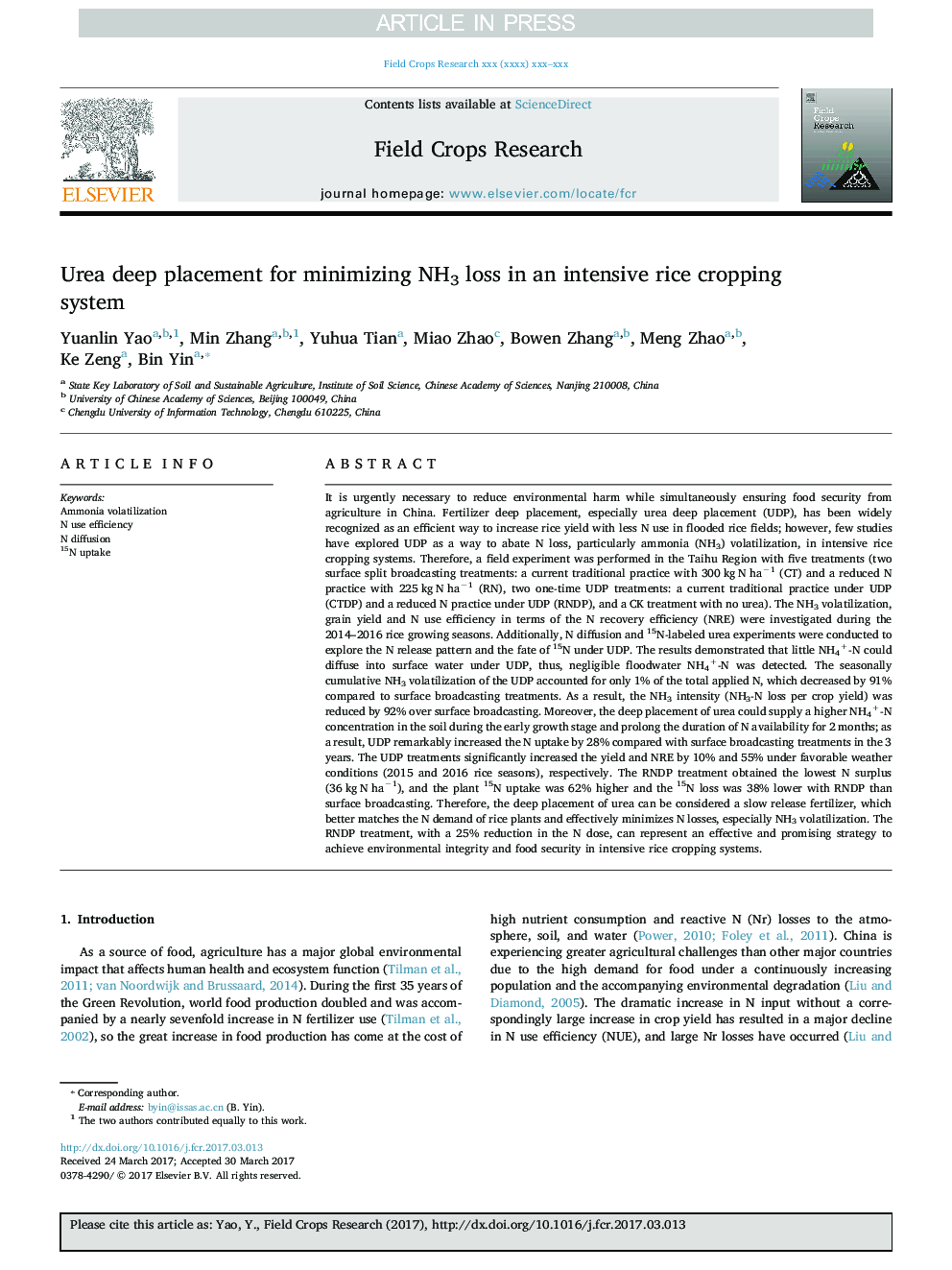| کد مقاله | کد نشریه | سال انتشار | مقاله انگلیسی | نسخه تمام متن |
|---|---|---|---|---|
| 8879377 | 1624645 | 2018 | 13 صفحه PDF | دانلود رایگان |
عنوان انگلیسی مقاله ISI
Urea deep placement for minimizing NH3 loss in an intensive rice cropping system
دانلود مقاله + سفارش ترجمه
دانلود مقاله ISI انگلیسی
رایگان برای ایرانیان
موضوعات مرتبط
علوم زیستی و بیوفناوری
علوم کشاورزی و بیولوژیک
علوم زراعت و اصلاح نباتات
پیش نمایش صفحه اول مقاله

چکیده انگلیسی
It is urgently necessary to reduce environmental harm while simultaneously ensuring food security from agriculture in China. Fertilizer deep placement, especially urea deep placement (UDP), has been widely recognized as an efficient way to increase rice yield with less N use in flooded rice fields; however, few studies have explored UDP as a way to abate N loss, particularly ammonia (NH3) volatilization, in intensive rice cropping systems. Therefore, a field experiment was performed in the Taihu Region with five treatments (two surface split broadcasting treatments: a current traditional practice with 300 kg N haâ1 (CT) and a reduced N practice with 225 kg N haâ1 (RN), two one-time UDP treatments: a current traditional practice under UDP (CTDP) and a reduced N practice under UDP (RNDP), and a CK treatment with no urea). The NH3 volatilization, grain yield and N use efficiency in terms of the N recovery efficiency (NRE) were investigated during the 2014-2016 rice growing seasons. Additionally, N diffusion and 15N-labeled urea experiments were conducted to explore the N release pattern and the fate of 15N under UDP. The results demonstrated that little NH4+-N could diffuse into surface water under UDP, thus, negligible floodwater NH4+-N was detected. The seasonally cumulative NH3 volatilization of the UDP accounted for only 1% of the total applied N, which decreased by 91% compared to surface broadcasting treatments. As a result, the NH3 intensity (NH3-N loss per crop yield) was reduced by 92% over surface broadcasting. Moreover, the deep placement of urea could supply a higher NH4+-N concentration in the soil during the early growth stage and prolong the duration of N availability for 2 months; as a result, UDP remarkably increased the N uptake by 28% compared with surface broadcasting treatments in the 3 years. The UDP treatments significantly increased the yield and NRE by 10% and 55% under favorable weather conditions (2015 and 2016 rice seasons), respectively. The RNDP treatment obtained the lowest N surplus (36 kg N haâ1), and the plant 15N uptake was 62% higher and the 15N loss was 38% lower with RNDP than surface broadcasting. Therefore, the deep placement of urea can be considered a slow release fertilizer, which better matches the N demand of rice plants and effectively minimizes N losses, especially NH3 volatilization. The RNDP treatment, with a 25% reduction in the N dose, can represent an effective and promising strategy to achieve environmental integrity and food security in intensive rice cropping systems.
ناشر
Database: Elsevier - ScienceDirect (ساینس دایرکت)
Journal: Field Crops Research - Volume 218, 1 April 2018, Pages 254-266
Journal: Field Crops Research - Volume 218, 1 April 2018, Pages 254-266
نویسندگان
Yuanlin Yao, Min Zhang, Yuhua Tian, Miao Zhao, Bowen Zhang, Meng Zhao, Ke Zeng, Bin Yin,